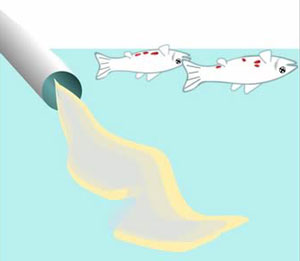Mechanistically Plausible Cause
Concept
Mechanistically Plausible Cause: The relationship between the cause and biological effect must be consistent with known principles of biology, chemistry and physics, as well as properties of the affected organisms and the receiving environment.
For this type of evidence, analysis consists of identifying a mechanism by which the candidate cause could cause the specific biological effects, and supporting the mechanism with compelling logic or relevant literature citations. It is important to distinguish a lack of information concerning a mechanism (e.g., it is not known whether chemical X induces tumors) from evidence that a mechanism is implausible (e.g., it is known that chemical X does not induce tumors). In addition, the possible role of indirect mechanisms in generating the impairment should be kept in mind (see Figure 4-4).

Click to view more information
Examples
Consider increased bedded sediment as a candidate cause for reduced species richness of fish. What findings support or weaken the case for bedded sediments as a cause, based on evidence for a mechanistically plausible cause?
- Supporting evidence - Monitoring data show that species richness of fish which clean sediments from the streambed for nesting has not been reduced, while species richness of fish which require clean gravel for spawning is greatly diminished. Numerous studies have shown that increased bedded sediment decreases rocky spawning habitat, resulting in decreases in species requiring these areas. Studies also have shown that nest-cleaning taxa are better able to succeed under high sediment conditions. Thus, it is plausible, based on mechanism, that bedded sediments are causing the observed impairment.
- Weakening evidence - Monitoring data at the site show that although overall fish species richness has declined, species requiring clean gravel have not been affected. Given the studies discussed above, it is unlikely, based on mechanism, that bedded sediments are causing the observed impairment.
How Do I Analyze the Data?
Evaluation of evidence for mechanistically plausible cause forces investigators to explicitly consider whether the proposed causal relationships make mechanistic sense. This process may be especially helpful when multiple stakeholders with widely varying scientific backgrounds are involved in identifying candidate causes, because they may suggest implausible causes.
What Evidence Would Support or Weaken the Case for a Candidate Cause?
- Data from other studies showing that the proposed mechanism can plausibly induce the observed effect, or lead to exposure
- Data from other studies showing that the proposed mechanism can not plausibly induce the observed effect, or lead to exposure
How Do I Score the Evidence?
| Finding | Interpretation | Score |
|---|---|---|
| The observed relationship between exposure and effects in the case agrees with the results of a simulation model. | This finding somewhat supports the case for the candidate cause, but is not strongly supportive because models may be adjusted to simulate the effects. | + |
| A plausible mechanism exists. | This finding somewhat supports the case for the candidate cause, but is not strongly supportive because levels of the agent may not be sufficient to cause the observed effect. | + |
| No mechanism is known. | This finding neither supports nor weakens the case for the candidate cause. | 0 |
| The candidate cause is mechanistically implausible. | This finding strongly weakens the case for the candidate cause, but is not convincing because the mechanism could be unknown. | -- |
Helpful Tips
- It is important to consider the exact nature of the impairment, especially whether the impairment is defined in terms of relative versus total abundance.
- It is easiest to consider mechanisms when the impairment is described as specifically as possible (e.g., reduced abundance of gravel spawning fish versus reduced total fish abundance).
- Note that it is not possible to refute the case for a candidate cause using evidence based on mechanistically plausible causes.
